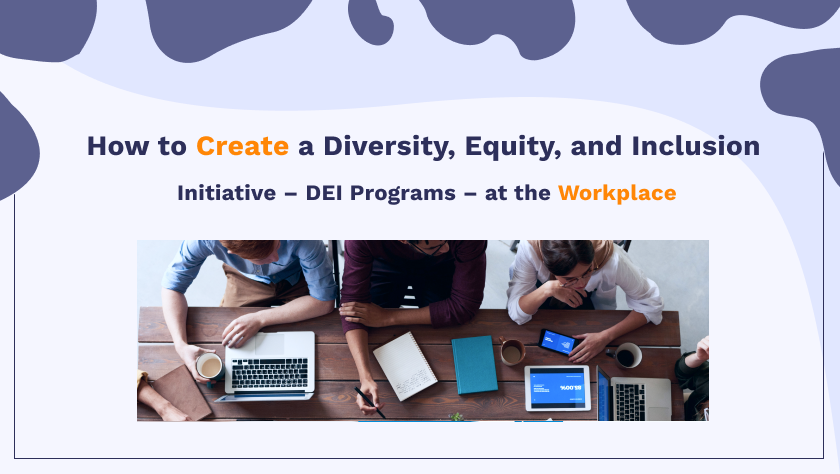Diversity, equity, and inclusion in the workplace are arguable topics highly discussed in the industry – specifically, in Human Resources. It’s a known fact that DEI programs in the office have shown positive results in productivity, creativity and innovation, decision-making, employee morale, and sales and profits.
But, even when employers and firms incorporate diversity, why do they see little progress in their team?
Our article covers numerous issues to realize and decipher the complex aspects of DEI. If you’re a business owner wanting to incorporate diversity, equity, and inclusion into the workforce, we’ve got the answers for you.
Difference between diversity, equity, and inclusion in DEI programs
The terms are often mixed and used interchangeably, which presents a huge misunderstanding and wrong perception when practiced. That’s why DEI programs remain lackadaisical and doomed to fail.
To understand what’s working, we need a clear definition of the terms.
What is diversity?
When a workplace is diverse, it accepts and values differences between people of different ethnicities, genders, ages, religions, disabilities, and sexual orientations. Not only that, but it also encompasses differences in knowledge, skills, education, and personalities. Diversity is often the first phase of the DEI concept.
What is inclusion?
Now, even if you have your diverse pool of talents, there’s no guarantee that the workplace will be able to appreciate and accept them. Inclusion is about welcoming the involvement, presence, and ideas of every team member. When short of inclusion, a firm’s diversity program is futile.
What is equity?
After welcoming your diverse team in the company, you need to ensure that everyone has equal opportunities for resources, pay, training, and support systems. Example of equity situations you can tackle:
- Are promotions limited only to abled employees? How about people with disabilities?
- Do you have gender sensitivity programs like harassment also for males in the workplace?
- Are the baby boomer’s lagging behind some innovative approaches in the company?
Until employers embrace these three factors, you won’t be getting results from your programs nor advancing your company’s bright prospects.
Why there’s a need to balance DEI?
Too often, diversity and inclusion are practiced without an equity basis. When the three go together, your workforce is empowered to greater innovation and productivity. That’s because equity offers your diverse team equal opportunities and a well-leveled playing field.
Diversity x equity
While the company is open to diversity and opportunities in the workplace, without inclusion, the employee might feel distant and dismissive. For instance, higher and equal pay in a company doesn’t compensate for the respect, employee engagement, and the feeling of belongingness in the firm.
Diversity x inclusivity
Without equity, the firm lacks depth-dimensional leadership, good problem-solving approaches, and high employee morale. For instance, some groups in a company e.g. women of color, PWDs, LGBTQ+, baby boomers, etc., left unheard proves dissatisfaction and attrition.
Equity x inclusivity
The company shuts away from diversity and limits itself from opportunities over the preference of a collective whole. What the firm lacks thereof is innovation, fresh ideas, and new perspectives.
If your company is planning to launch DEI programs in the workplace, you need a lot of introspection on your internal practices and – personal biases.
Statistics that prove a growing demand for DEI programs
According to Glassdoor, a company review website, workplace diversity accounts for 67% of job seekers’ consideration when searching for employment opportunities. Among the respondents are:
19.3% are PWDs
70% are Latinos
72% are women
80% are Asians
89% of African descent
If employers won’t include DEI in their programs, they’ll be missing a lot of talent pools and prospective opportunities.
According to Culture Amp, 40% feel left out in the business decision-making process which leads to employee resignation. The results of the survey found it unfortunate enough since women often bring the best ideas on the table.
That study is backed up by Fast Company in a study that says women in C-suite level positions provide 34% higher yields of returns on investment.
DEI programs also provide the following results:
- Diverse teams outperform norm-tendency teams by 87%.
- Diverse companies outperform competitors in the industry by 35%.
- Firms with high inclusion of diverse teams had 19% growing revenues.
- Businesses with 2D diversity captured new markets by 45% and have entered about 70% of the industry as well.
- Companies improved their creations, works, and services by 27% with diverse teams.
So, why shouldn’t you include a great talent pool in your company? Companies rich in diversity, equity, and inclusion are the ones that usually succeed.
7 action steps to promote DEI
Diversity doesn’t end in the hiring process; rather, it begins when the employee embraces themselves as a part of the organization. So, what are diversity, equity, and inclusion in the workplace?
To create successful DEI programs, this has to be an executive strategy. Too often HR managers find themselves implementing these initiatives with 65% of senior executives believe it’s not their job to promote.
If you want to create change in the workplace, here’s what you need to do.
Collect and compile data. Employers should know what their company is like by collecting and compiling data from their employees. One can study and understand better how diversity affects the firm through internal practices.
You can start by knowing your employees’:
- Age
- Disability
- Race and ethnicity
- Gender or sexual preferences
- Language
- Educational background
- Personality type, etc.
Companies don’t need to snoop around their files. You can even gather all your employees’ activity and let them introduce themselves. It’s a way of gauging their reactions, thoughts, and personality naturally.
Identify and analyze areas of concern. Once you’ve collected enough data and information on your employees, you can analyze the representation of diversity, inclusion, and equity on your team. Ask yourselves of these questions:
- Are we hiring enough diverse teams?
- Why is this department hiring only male employees? Do you have any programs such as STEM for women?
- Are the management leaders and decision-makers are all males?
These areas of concern can be discussed within the management level, HR department, or, for smaller companies, within your groups.
Address policies, practices, and company objectives. Discuss policies, practices, and company objectives that hinder employment and rewards opportunities. Include the following practices:
- Benefits and rewards program
- Personal biases in departments
- Company culture and engagement
- Company training and informational workshops about DEI programs
- Support systems for PWDs’ assistance, gender harassment, and racial discriminations
Create SMART objectives. Create specific, measurable, attainable, realistic, and time-bound objectives for your DEI programs. For example: to increase diverse employee morale for higher productivity and profits for 6 months.
Specific: Increase diverse employee morale
Measurable results: employee productivity, morale, turnover, attendees, absentees, and retention
Attainable: with diverse teams
Realistic: employee morale and workmanship
Time-bound: 6 months
Implement the initiatives. What activities and programs you can include for your DEI initiatives? It’s also important to include the executive and management level when implementing policies, programs, and initiatives. For example:
- Create monthly training and outreach for the company
- Invest in technology for PWDs
- Change in the hiring process
- Penalties in discrimination
- Mental health support
- Performance and business reviews
- Opportunities for bonuses, salary increases, and promotions
Measure the program. To understand how your programs are geared for success, you need to measure the results of the DEI initiatives. That way, you’ll know that your programs are implemented effectively. You can measure the feat of your programs through:
- Employee retention
- Company productivity
- Employee morale and turnover
- Attendees and absentees
- Happiness engineering
Review, evaluate, and repeat. DEI is a continuous work and response to the changing needs of the company. The firm must create a regular review of the programs, then adapt, change, and initiate the programs accordingly.




